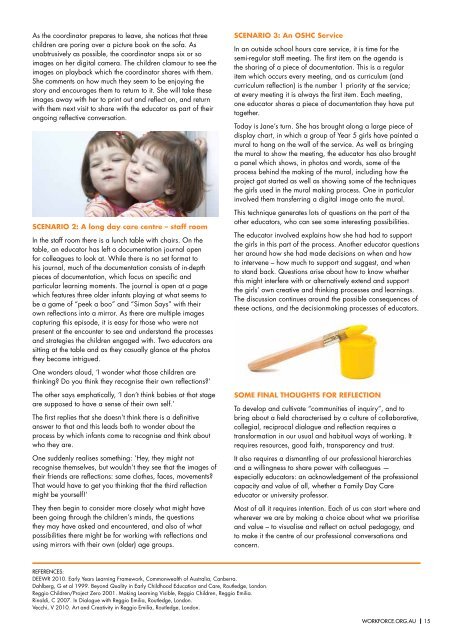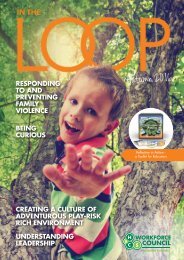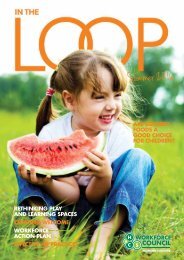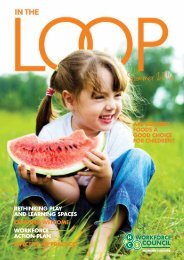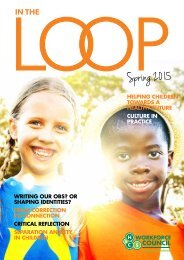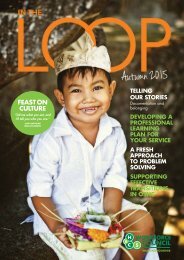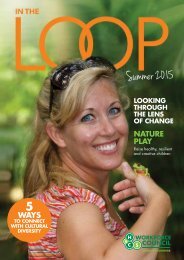In the Loop Winter 2016
Create successful ePaper yourself
Turn your PDF publications into a flip-book with our unique Google optimized e-Paper software.
As <strong>the</strong> coordinator prepares to leave, she notices that three<br />
children are poring over a picture book on <strong>the</strong> sofa. As<br />
unobtrusively as possible, <strong>the</strong> coordinator snaps six or so<br />
images on her digital camera. The children clamour to see <strong>the</strong><br />
images on playback which <strong>the</strong> coordinator shares with <strong>the</strong>m.<br />
She comments on how much <strong>the</strong>y seem to be enjoying <strong>the</strong><br />
story and encourages <strong>the</strong>m to return to it. She will take <strong>the</strong>se<br />
images away with her to print out and reflect on, and return<br />
with <strong>the</strong>m next visit to share with <strong>the</strong> educator as part of <strong>the</strong>ir<br />
ongoing reflective conversation.<br />
SCENARIO 2: A long day care centre – staff room<br />
<strong>In</strong> <strong>the</strong> staff room <strong>the</strong>re is a lunch table with chairs. On <strong>the</strong><br />
table, an educator has left a documentation journal open<br />
for colleagues to look at. While <strong>the</strong>re is no set format to<br />
his journal, much of <strong>the</strong> documentation consists of in-depth<br />
pieces of documentation, which focus on specific and<br />
particular learning moments. The journal is open at a page<br />
which features three older infants playing at what seems to<br />
be a game of “peek a boo” and “Simon Says” with <strong>the</strong>ir<br />
own reflections into a mirror. As <strong>the</strong>re are multiple images<br />
capturing this episode, it is easy for those who were not<br />
present at <strong>the</strong> encounter to see and understand <strong>the</strong> processes<br />
and strategies <strong>the</strong> children engaged with. Two educators are<br />
sitting at <strong>the</strong> table and as <strong>the</strong>y casually glance at <strong>the</strong> photos<br />
<strong>the</strong>y become intrigued.<br />
SCENARIO 3: An OSHC Service<br />
<strong>In</strong> an outside school hours care service, it is time for <strong>the</strong><br />
semi-regular staff meeting. The first item on <strong>the</strong> agenda is<br />
<strong>the</strong> sharing of a piece of documentation. This is a regular<br />
item which occurs every meeting, and as curriculum (and<br />
curriculum reflection) is <strong>the</strong> number 1 priority at <strong>the</strong> service;<br />
at every meeting it is always <strong>the</strong> first item. Each meeting,<br />
one educator shares a piece of documentation <strong>the</strong>y have put<br />
toge<strong>the</strong>r.<br />
Today is Jane’s turn. She has brought along a large piece of<br />
display chart, in which a group of Year 5 girls have painted a<br />
mural to hang on <strong>the</strong> wall of <strong>the</strong> service. As well as bringing<br />
<strong>the</strong> mural to show <strong>the</strong> meeting, <strong>the</strong> educator has also brought<br />
a panel which shows, in photos and words, some of <strong>the</strong><br />
process behind <strong>the</strong> making of <strong>the</strong> mural, including how <strong>the</strong><br />
project got started as well as showing some of <strong>the</strong> techniques<br />
<strong>the</strong> girls used in <strong>the</strong> mural making process. One in particular<br />
involved <strong>the</strong>m transferring a digital image onto <strong>the</strong> mural.<br />
This technique generates lots of questions on <strong>the</strong> part of <strong>the</strong><br />
o<strong>the</strong>r educators, who can see some interesting possibilities.<br />
The educator involved explains how she had had to support<br />
<strong>the</strong> girls in this part of <strong>the</strong> process. Ano<strong>the</strong>r educator questions<br />
her around how she had made decisions on when and how<br />
to intervene – how much to support and suggest, and when<br />
to stand back. Questions arise about how to know whe<strong>the</strong>r<br />
this might interfere with or alternatively extend and support<br />
<strong>the</strong> girls’ own creative and thinking processes and learnings.<br />
The discussion continues around <strong>the</strong> possible consequences of<br />
<strong>the</strong>se actions, and <strong>the</strong> decisionmaking processes of educators.<br />
One wonders aloud, ‘I wonder what those children are<br />
thinking? Do you think <strong>the</strong>y recognise <strong>the</strong>ir own reflections?’<br />
The o<strong>the</strong>r says emphatically, ‘I don’t think babies at that stage<br />
are supposed to have a sense of <strong>the</strong>ir own self.’<br />
The first replies that she doesn’t think <strong>the</strong>re is a definitive<br />
answer to that and this leads both to wonder about <strong>the</strong><br />
process by which infants come to recognise and think about<br />
who <strong>the</strong>y are.<br />
One suddenly realises something: ‘Hey, <strong>the</strong>y might not<br />
recognise <strong>the</strong>mselves, but wouldn’t <strong>the</strong>y see that <strong>the</strong> images of<br />
<strong>the</strong>ir friends are reflections: same clo<strong>the</strong>s, faces, movements?<br />
That would have to get you thinking that <strong>the</strong> third reflection<br />
might be yourself!’<br />
They <strong>the</strong>n begin to consider more closely what might have<br />
been going through <strong>the</strong> children’s minds, <strong>the</strong> questions<br />
<strong>the</strong>y may have asked and encountered, and also of what<br />
possibilities <strong>the</strong>re might be for working with reflections and<br />
using mirrors with <strong>the</strong>ir own (older) age groups.<br />
SOME FINAL THOUGHTS FOR REFLECTION<br />
To develop and cultivate “communities of inquiry”, and to<br />
bring about a field characterised by a culture of collaborative,<br />
collegial, reciprocal dialogue and reflection requires a<br />
transformation in our usual and habitual ways of working. It<br />
requires resources, good faith, transparency and trust.<br />
It also requires a dismantling of our professional hierarchies<br />
and a willingness to share power with colleagues —<br />
especially educators: an acknowledgement of <strong>the</strong> professional<br />
capacity and value of all, whe<strong>the</strong>r a Family Day Care<br />
educator or university professor.<br />
Most of all it requires intention. Each of us can start where and<br />
wherever we are by making a choice about what we prioritise<br />
and value – to visualise and reflect on actual pedagogy, and<br />
to make it <strong>the</strong> centre of our professional conversations and<br />
concern.<br />
REFERENCES:<br />
DEEWR 2010. Early Years Learning Framework, Commonwealth of Australia, Canberra.<br />
Dahlberg, G et al 1999. Beyond Quality in Early Childhood Education and Care, Routledge, London.<br />
Reggio Children/Project Zero 2001. Making Learning Visible, Reggio Children, Reggio Emilia.<br />
Rinaldi, C 2007. <strong>In</strong> Dialogue with Reggio Emilia, Routledge, London.<br />
Vecchi, V 2010. Art and Creativity in Reggio Emilia, Routledge, London.<br />
WORKFORCE.ORG.AU 15


